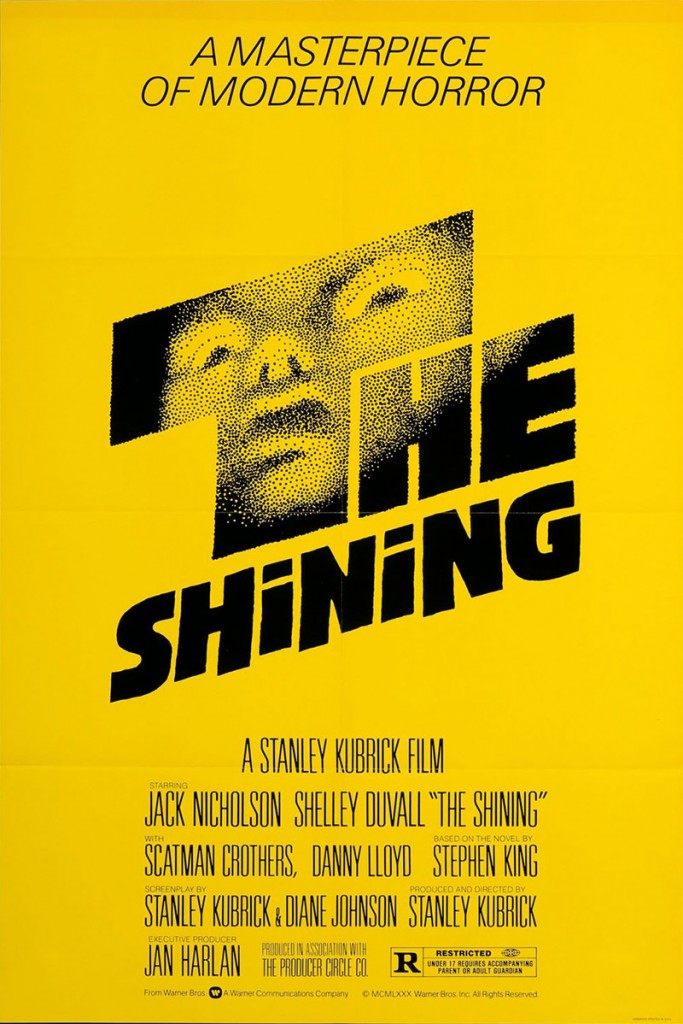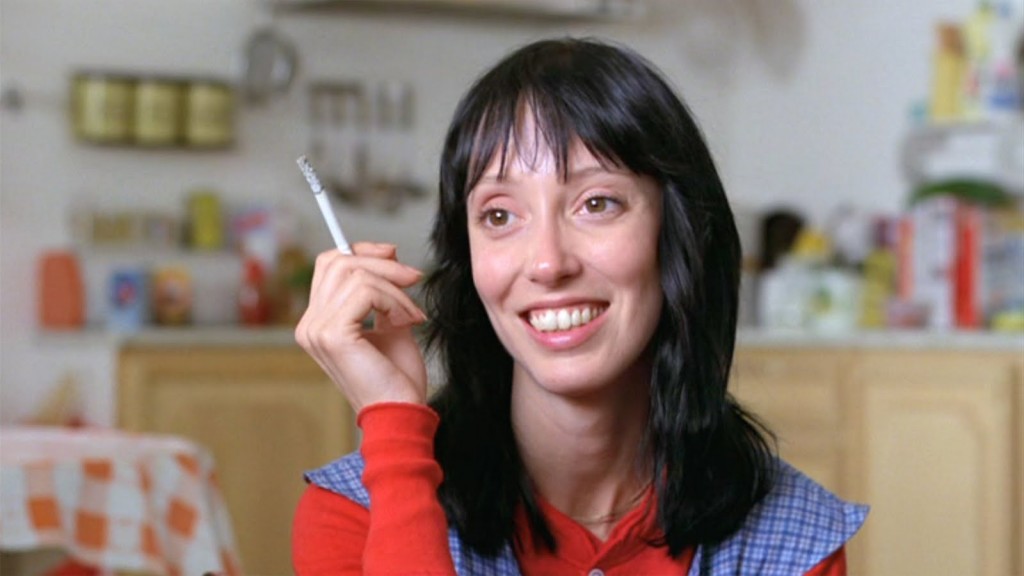It’s October. With Halloween hot on our heels, we thought it appropriate to take a look at legendary horror author Stephen King’s best, worst, and strangest translations from page to screen. Baby, can you dig your man?
“The movie was good but the book was better.” Ah, yes, that reliable old adage that seems applicable to just about every book-to-film adaptation. The idea is so consistent that it gives me an incessant need to run out and read every book before its much anticipated blockbuster film release, just so I can be savvy on the hype (and also perhaps so I can be snooty about the book’s superiority). When you apply that concept to Stanley Kubrick’s masterful adaptation of Stephen King’s The Shining, however, it crumbles; the book isn’t better than the movie. But the movie isn’t better than the book, either.
Kubrick’s The Shining is a classic. Attempting to write any additional commentary on it here would be like throwing a drop of water in the sea of reviews, conspiracy theories, and documentaries about those conspiracy theories that already exist. I’ve read them and seen them, and you probably have, too. After finally reading the book last Halloween, however, the most striking thing about Kubrick’s vision to me is that it’s a funhouse mirror image of King’s story. Every little bit of hope and heroism that exists on the page gets hacked to pieces with an axe on screen. All of the triumphs that the characters experience translate to failure. The film is the book’s worst nightmare.
This is especially true for Jack Torrance. Jack Nicholson’s performance as this character is undeniably iconic. He’s terrifying, and he’s terrifying from the get-go. When Shelley Duvall (as wife Wendy Torrance) shakily lights a cigarette while brushing off the fact that Jack had abused their son, you realize that Jack’s family is already afraid of him. In the book, however, Jack is a decent guy, or at least he wants to be. King pours himself into Jack Torrance, along with all of his fears regarding family life and his own personal battle with alcohol. It’s his love for his family that makes Jack’s transformation so chilling, as the reader watches his thoughts go from doting on his son, Danny, to murdering him. Movie Jack is bereft of humanity. He terrorizes his family until he dies. Meanwhile, book Jack actually has a moment of clarity before the end, fighting off the darkness briefly before fully succumbing to it, telling his son that he loves him and allowing him to escape before smashing his own head in with a roque mallet. It’s a moment that should feel like redemption, but it falls just short of it. Danny may know that his father loves him, but it doesn’t change the fact that his father once broke his arm in a drunken fit. However, it’s still a degree closer to absolution than movie Jack, who was looking at his son like a piece of gum stuck to his shoe well before they arrived at the Overlook Hotel.
Film Danny, like his film father, gets stripped down to a simplistic version of himself—a child. A child with a gift, sure, but nothing like his book counterpart. In keeping with the tradition of Stephen King writing children with supernatural abilities, Danny is more powerful than any adult around him—even Dick Hallorann, who also has the shine. Despite the fact that it’s still the namesake of the film, the “shining” itself is a passive element. The viewer never gets inside Danny’s head like they do in the book, and Danny never adds to the dialogue surrounding his father’s very obvious descent into madness. “The shining” in the film seems to just mean that Danny sees more ghosts than his parents, and that he can text message Dick with his brain. The most he ever speaks at once in the movie is when he repeats “REDRUM” over and over in his off-putting, faux-demon voice. Movie Danny joins Damien of The Omen and the little boy from The Grudge as quiet, creepy horror movie children who act as a pivot point for terror.
Danny’s imaginary friend, Tony, whom he can actually see in the book, warns him of all the terrors his family is sure to face in the hotel. The two have a kind of constant dialogue, and it’s Tony’s somewhat adult voice in the back of Danny’s head that makes him the clever and acutely perceptive child that he is. In the film, Danny speaks to Tony with his index finger, which is somehow endearing and unnerving at the same time, and Tony shows him visions of what is to come—the river of blood, the twin girls, and the bloody axe flashing like violent subliminal messages in his mind. And because film Danny can’t really do anything with these visions, even warn his mother, he’s as much of a spectator as the audience, whereas in the book, Danny is waging war against the Overlook with his shine. And the Overlook is afraid of him.
King’s book is one of the most thoughtful approaches to horror I have read. The darkness at the Overlook is insidious; it gets off on making people kill their loved ones, and it likes to takes its time. And it equates axe murder with the horrors of daily life, like hitting your child in a moment of anger or getting a divorce. Thanks to the book, I don’t think I’ll ever be able to look at an animal topiary the same way again due to the hedge lion that stalks Danny. Nor will I ever not be creeped out every time my spouse, who listened to the audiobook with me, jokingly growls “take your damn medicine” (a line that Jack spouts often in the book when he’s thinking about murder) when I eat my daily gummy vitamin.
But despite the masterful writing, book Jack will never be as frightening as Jack Nicholson swinging an axe into a door with such ferocity that he swings the camera along with him. In fact, a lot of the terror in the film is created by the dynamic camera work as it relentlessly pulls the audience into scenes, chasing actors down hallways or crawling into small spaces with Danny as he hides. There’s a lot of anxiety created in the tricycle scene in particular, as the camera follows Danny as he peddles through large open rooms and turns back and forth in the hotel’s labyrinthine hallways (mirroring the final snowy scene in the actual labyrinth), seeing what’s around the corner a mere second before the audience. There’s no soundtrack for this scene, just a lot of silence and the sound of the plastic wheels alternating between carpet and wood floor. All of that anxiety builds and crescendos when Danny turns the final corner and comes face to face with the twins, and it is only then that the soundtrack makes itself known.
Just like the Overlook’s boiler that Jack has to tend to in the book, the film’s soundtrack has a tendency to “creep.” When all is normal, it’s pretty neutral and quiet, but when the horror starts to rise, so does the temperature and the shrieking violins. Take, for instance, one of the film’s many horror climaxes, when a dumbfounded and terrified Wendy sees a wall of blood pour out of the hotel’s elevator. The film audience may not know the specifics about that elevator’s terrifying reputation in the book, but that red visual paired with the chaotic, unsettling strings in the soundtrack tell all the horror story you need.
The film also differs from the book by failing to invest the audience in the characters. Not that people want to see a woman and child get murdered, but no one actively roots for flat characters, either. Stanley Kubrick negated the need for any kind of real relationships or depth among his characters by simply terrorizing them, quite literally, along with the audience. Fear is the emotion. It’s no secret that Shelley Duvall suffered on set, and that Kubrick allowed it. The infamous scene in which Jack Nicholson creeps up to Duvall on the stairs as she whimpers and weakly swings a bat at him had more than 100 takes. Duvall’s tears and terror were very genuine, and Nicholson’s ever-increasing deranged demeanor and his ability to emote rage and gleeful violence and incredulous frustration all in one take is unnerving. Kubrick may be a genius when it comes to impeccably constructing a scene, but it’s Nicholson that really drives it home with his performance.
The true horror of the film is that the Overlook wins. Danny never has a chance against either the darkness or his sadistic father, and Jack has no qualms about allowing the hotel to absorb him into its history of murder and mayhem. A lot of this has to do with Kubrick, perhaps intentionally, missing the mark on the shining itself. Because book Danny is so much more powerful than his film counterpart, he can defeat the Overlook, allowing the boiler to “creep” and blowing up the hotel along with whatever is left of his father, essentially freeing Jack from his possession and salting the earth so that the darkness could no longer take root. The tortured family has at least some kind of victory over the horrors they endured, and so the readers get something like closure. But the film denies its characters and its audience any kind of hope or closure—everyone gets tortured for naught. Jack isn’t freed and the hotel isn’t demolished. The Overlook and Nicholson’s Jack Torrance are eternal, living forever in Kubrick’s masterpiece.
Check back all this month for more essays on Stephen King stories on screen.


